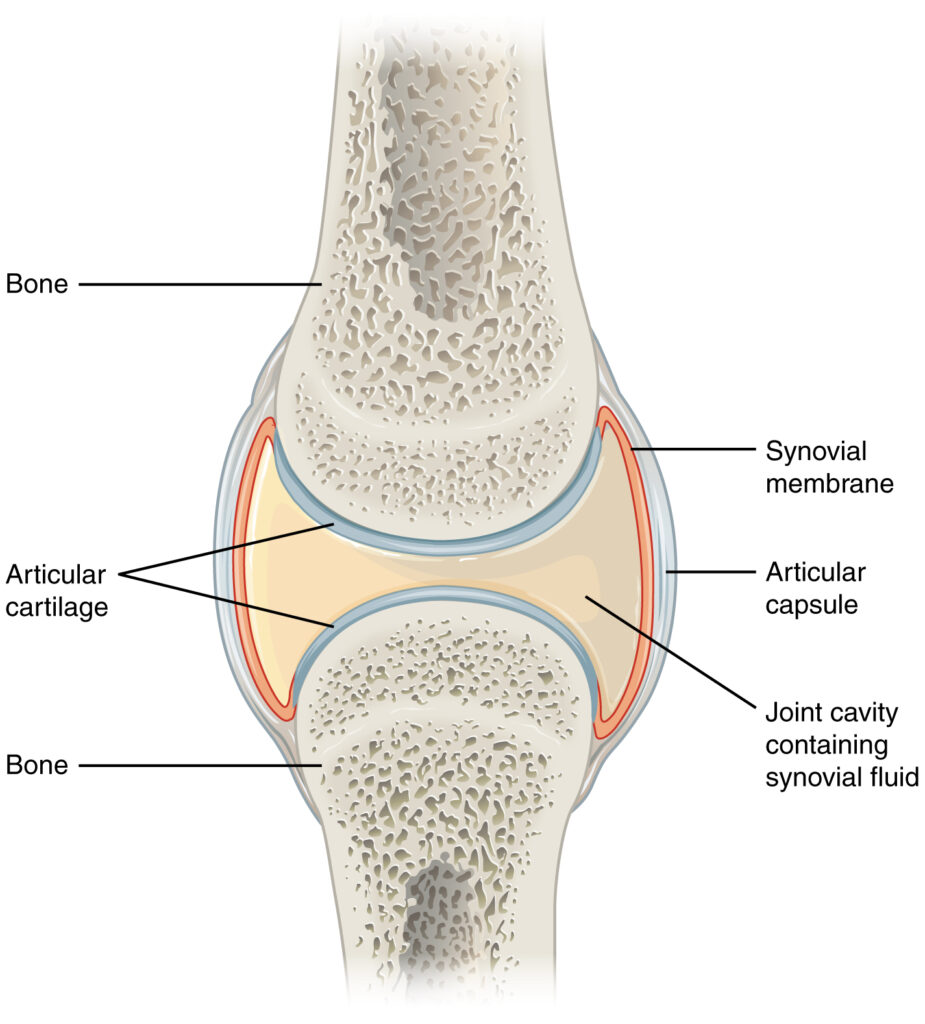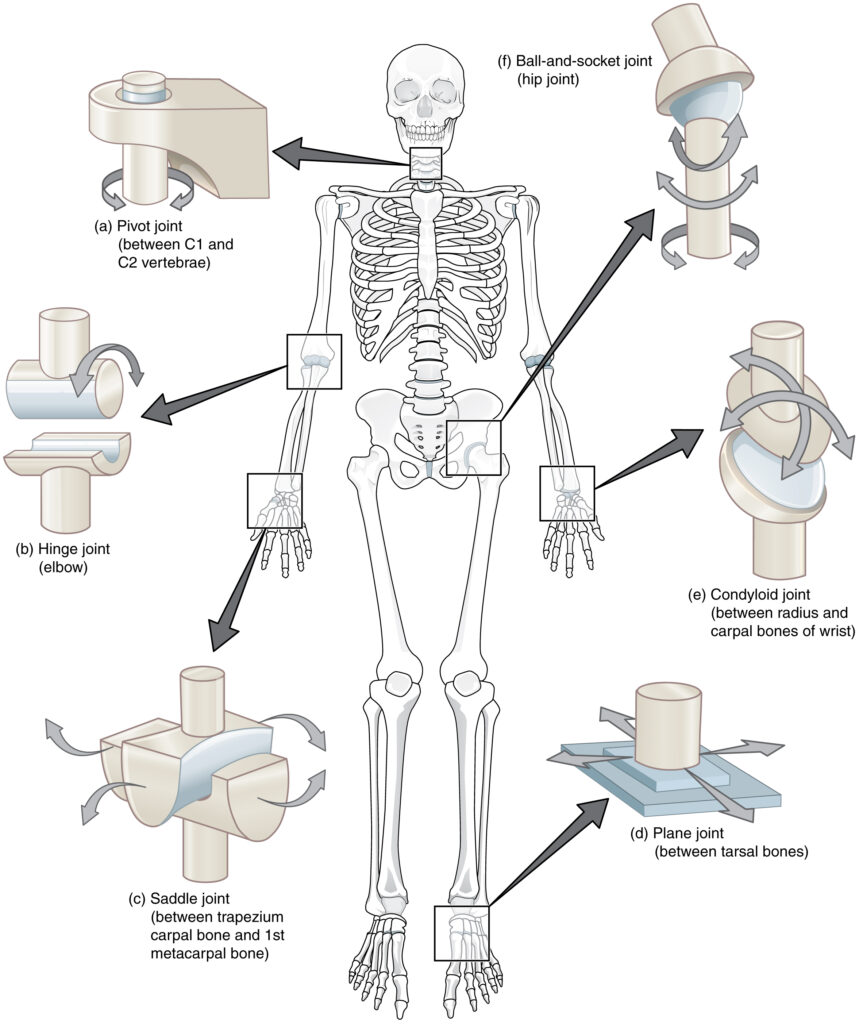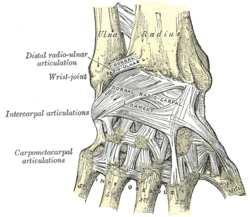INTRODUCTION
joints in human body
- Joints are structural arrangement where two bones articulate i.e., meet each other. The framework of the body consists of separate skeletal elements which are joined or articulate with one another by different types or joints. The joints are essential for the movement of different skeletal structures i.e., all the bones present in the body produce movement due to the movement of these joints. Locomotory movements occur due to these joints, where these act as lever or fulcrum.
- The movability in joints varies. On the basis of movability, joints are classified into three major joints:-
Joints
|
Fibrous joints Cartilaginous joints Synovial joints
__________________________________________________|__________
| | | | | |
Ball and Ellipsoid Hinge Pivot Gliding Saddle
socket joints angular joint joint joint joint joint
Joints are classified into
three major joints:-
A. Fibrous or Immovable or Fixed or Synarthrose Joints
These joints do not allow any movement because the bones are firmly fixed together by strong collagen fibres. These joints in the skull are called sutures. The attachement of tooth with socket in jaw is also an example of fixed joints.
B. Cartilaginous or Imperfect or Amphiarthroses or
Slightly Movable Joints:-
In these joints, the two bones are joined together with help of a disc or pad of white fibrous cartilage. The disc of cartilage restricts the movement in these joints due to which these joints show limited or slight movement. The movement in these joints are only possible because of compression of the pads of cartilage present on the articulated or ends of the bone taking part in the joints. The cartilaginous joint is present between the adjacent vertebrae of vertebral column and hence allows limited movement. They are also present in sternum-ribs (costal cartilages), pubic symphysis etc
C. Synovial or Free Movable or Diarthrose Joints:-
Synovial joints are free movable joint which allow movement in one or more directions. The bones of these joints are covered by a membrane called synovial membrane. Inside the membrane and between the two articulating surfaces of the bone, synovial cavity is present. This cavity is filled with synovial fluid that acts as a lubricant which nourishes the bones with nutrients and also acts as a cushion to absorb shocks. The fluid helps in movement of bones in all possible directions and also provide stability to the joint. Both the ends of the bones forming the joints is covered by hyaline cartilage called articular cartilage. It prevents the ends of the bones from being separated.

joints in human body
According to the shape and movement
performed by synovial joints:-
six different types of synovial joints are present.
(i) Ball and socket joint:- Ball and socket joint is the most free joint of all joints. It shows movements in different directions. The articulate end of one bone is in the shape of a ball whereas the end of the other bone is in the shape of a cup. The ball of one bone is fitted into the socket of the other bone e.g., shoulder joint and hip joint.
(ii) Hinge joint:– Hinge joint is a joint which allows movement only In one plane. In ahinge joint, The end of one bone is deep convex in shape and the end of other bone is deep concave in shape. The convex end of the bone articulates with the concave end of the other bone and allow movement only in one plane e.g., elbow joint, knee joint.
(iii) Pivot joint:– The pivot joint allows movement in one plane. The primary movement at the pivot joint is rotation. Two bones articulate with each other where end of one bone is rounded or pointed which fits into a shallow depression of the other bone. The rounded end of the bone is fixed or stationary whereas the other bone rotates over it e.g., joint between the radius and ulna just below the elbow and between atlas and axis.

joints in human body
According to the shape and movement
performed by synovial joints:-
six different types of synovial joints are present (cont..)
(iv) Gliding joint:- It is the simplest of synovial joint. The articulate ends of the bones are flat or slightly curved so that the bones can easily glide or slide over each other. This joint allows movement only in one direction i.e., side ti side movement, no twisting or rotational movement is possible because the bones are packed closely or held in place by ligaments e.g., tarsal and carpals
(v) Saddle joint:– Saddle joint is a in which one ball or convex head of one bone fixes into saddle-like depression of the other bone. It is atype of ball and socket joint and hence allows movement in many direction e.g., between carpals and metacarpals of human thumb.
(vi) Angular or condyloid or ellipsoid joint:– It is type of joint in which articulate end of one bone is oval and convex and the articulate and of the other is elliptical and concave. The oval or convex end fits into the elliptical or concave end and causes movement only in two directions i.e., back and forth or side to side e.g., joint between radius and carpal.

Funfacts:-
Most Movable Joint: The shoulder joint is the most movable joint in the human body, allowing for a wide range of motion. However, this flexibility also makes it prone to dislocations.
Strongest Joint: The knee joint is the largest and strongest joint in the body. It supports the body’s weight and endures significant stress during activities like running and jumping.
Complexity of the Hand: The hand contains 27 bones and 29 major joints, making it one of the most complex anatomical structures in the body. This complexity allows for the intricate movements necessary for tasks like writing, grasping objects, and playing musical instruments.
Cartilage Importance: Cartilage, a firm but flexible connective tissue, cushions and stabilizes joints. It’s found at the ends of bones and between joints, helping to reduce friction and absorb shock during movement.
Synovial Fluid: Joints contain synovial fluid, a viscous fluid that lubricates and nourishes the joint tissues. This fluid helps reduce friction between the bones and allows for smooth movement.
Types of Joints: There are three main types of joints in the human body: fibrous joints (which are immovable, like those in the skull), cartilaginous joints (which allow limited movement, like those between vertebrae), and synovial joints (which are freely movable, like those in the limbs).
Ball-and-Socket Joints: Ball-and-socket joints, like the hip and shoulder joints, allow for the greatest range of motion in all directions, including rotation. They consist of a rounded, ball-like end of one bone fitting into a cup-like socket of another bone.
Hinge Joints: Hinge joints, such as the elbow and knee joints, allow movement primarily in one direction, like the opening and closing of a door. They consist of a convex surface of one bone fitting into a concave surface of another bone.
Meniscus in the Knee: The knee joint contains two crescent-shaped discs of cartilage called menisci, which act as shock absorbers and help distribute weight evenly across the joint surfaces.
Joint Disorders: Conditions such as arthritis, which involves inflammation of the joints, and osteoporosis, which leads to weakening of the bones, can affect joint health and mobility. Proper exercise, nutrition, and medical care can help maintain joint health and function.
A joint is the connection between two or more bones in the body. Joints allow for movement and provide mechanical support to the skeleton.
The human body contains over 300 joints, each serving a specific purpose and allowing for various types of movement.
There are three main types of joints: fibrous joints, cartilaginous joints, and synovial joints. Fibrous joints allow minimal to no movement, cartilaginous joints allow limited movement, and synovial joints are freely movable.
Common joint problems include arthritis (inflammation of the joints), osteoarthritis (degeneration of joint cartilage and underlying bone), rheumatoid arthritis (an autoimmune disorder affecting joints), and joint injuries such as sprains and dislocations.
Maintaining a healthy weight, exercising regularly to strengthen muscles and improve flexibility, avoiding repetitive high-impact activities, and consuming a balanced diet rich in nutrients that support joint health (such as omega-3 fatty acids and vitamin D) can help keep joints healthy.
Some joints have limited ability to repair themselves, particularly those with a good blood supply like the knee and shoulder. However, severe joint damage may require medical intervention such as surgery or joint replacement.
Risk factors for joint problems include aging, genetics, obesity, previous joint injuries, certain occupations or sports that involve repetitive movements or impact on the joints, and underlying medical conditions such as diabetes and autoimmune diseases.
Muscles play a crucial role in supporting and stabilizing joints. Strengthening the muscles around a joint can help reduce the risk of injury and improve joint function and mobility.
Yes, joint pain can be a symptom of various underlying conditions, including arthritis, autoimmune diseases, infections, and bone fractures. Persistent or severe joint pain should be evaluated by a healthcare professional.
You should see a doctor if you experience persistent or severe joint pain, swelling, redness, or difficulty moving a joint. These could be signs of a serious underlying condition that requires medical attention.